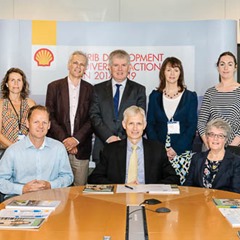Environmental management and biodiversity in infrastructure projects
 Shell E&P Ireland hosted a roundtable discussion on environmental management and biodiversity in Irish infrastructure projects.
Shell E&P Ireland hosted a roundtable discussion on environmental management and biodiversity in Irish infrastructure projects.
Why does environmental management and biodiversity matter in the delivery of infrastructure projects?
Michael Crothers
From a developer’s perspective, we have an obligation to balance the economic, social and environmental aspects. Increasingly, development cannot happen unless you have that social licence that comes from being able to demonstrate to communities that you can strike that balance.
Over the years, expectations have shifted as to what environmental protection actually means and biodiversity has become increasingly important. Shell started its journey in biodiversity about 10 years ago. It started as an initiative and is now embedded in how we do business. There is an inherent value in species and habitat that enriches our lives. As we learn more about ecology, there is an increasing awareness of the interdependency not only between animals and plants, but between the ecosystem and human beings.
If you shift your perspective as a company to take a longer view, you have to take into account the environmental impacts over the whole lifecycle of a project. You have to change the priority of your thinking from cost and schedule to include safety and environment. And that has to be about more than words – and I believe we have demonstrated that throughout the Corrib project.
In addition to meeting our legislative and policy commitments on biodiversity, we need to communicate why we need to protect it. We are part of the environment and that environment delivers goods and services that we depend on, for example clean water, pollination for food production, medical and pharmaceutical products and energy, to name but a few. Delivery of these essential services is underpinned by biodiversity and there is therefore a reason to protect it.
However, the reality of this link is not well communicated. In Ireland, we are just beginning to appreciate the contribution of biodiversity and its value. It has been estimated that biodiversity is worth
€2.6 billion annually to the Irish economy. But that is just a minimum estimate that does not take into account the full range of services biodiversity underpins.
Aoife Reynolds
In Ireland, we have a legacy issue. We have seen the construction industry take on board health and safety and it is now on a similar journey regarding biodiversity and environmental management.
It is important because if we do not make a step change, we will lose habitats and areas that are important to us. It is part of our culture and we need to take consideration of the location-specific requirements to maintain biodiversity and also develop our infrastructure appropriately.
Henk van der Kamp
Biodiversity is a concern because it is going down and that is why it matters. It matters for society as it is a common good. As a planner, what I find interesting – and also exciting – is that we can actually improve biodiversity. Therefore, it is not just a trade-off to minimise the physical impact of infrastructure developments.
Infrastructure, particularly linear infrastructure, is damaging because of severance with areas often cut into two. We need to minimise this in the way we design projects – and that is often at no cost.
Biodiversity is important at both a global and local level. On any project, the local impact feeds into the national and ultimately the global picture. The benefits of biodiversity can be seen in terms of ecosystem services, which are very important. There is a lack of communication and education with the public around this and it might be better understood if it were referred to by its full name of biological diversity instead of the contraction. The benefits of ecosystem services include health and welfare, a sense of well-being, aesthetics, and it is also important for tourism and the rural economy.
I would like to emphasise the importance of mitigation-based design. Environmental impacts should be taken into consideration from the very outset and the mitigation has to be built into the design. It is also important to involve key specialists at an early stage. As an ecologist I have worked with Irish habitats and species for nearly 40 years and in the early days developers would not have considered bringing in an ecologist or environmental scientist at the design/early planning phase. Thankfully that is changing, largely owing to the need to comply with legislation.
Fragmentation is a serious threat to habitats and species, particularly on major linear infrastructure projects such as roads. One aspect that greatly concerns me is the use of continuous solid central concrete medians and the resultant linear barrier effect to small mammals. In addition to underpasses for the larger species such as badgers, thought should be given to mitigation for smaller species too.
As an ecologist, I obviously have an appreciation for the environment. As a nation, however, we are just beginning to realise how we rely on the environment and the ecosystem goods and services it provides. When I started working 14 years ago, ecology was marginalised in thinking about developments and day-to-day living in general. Also, the focus has now moved from looking at isolated issues like water quality and habitat management to understanding whole ecosystems. While ecological thinking is now coming to the fore I still don’t think it is fully appreciated, valued or understood. Perhaps we need to use a different language and talk about ecosystems or natural capital, which is essentially underpinned by biodiversity.
We certainly need to create a more positive culture – one in which biodiversity or our natural capital is welcomed in any discussion about a development and not just seen as a negative. If we don’t, public trust will continue to be eroded. I hope we will be able to look back in 10 years’ time and see that the trust has been built up – but it will be a slow process.
Conor Ó Raghallaigh
The ecosystem services concept is key to engendering an acceptance of the importance of protecting biodiversity. We are part of nature and there are a lot of services that the environment gives to us that have, to date, not been factored into decision-making or planning. For example, one of the initiatives undertaken by the Department of Arts, Heritage and the Gaeltacht – which came about by infringement action by Europe on turf extraction – was to look at Ireland’s peatlands, which cover 20 per cent of the country. Earlier this year, the Government put out a draft peatlands strategy and one of the key questions is trying to understand the implications of peatlands management on ecosystems. Peat is a big issue as regards climate change but you also have to think about water quality, fisheries and the implications for forestry and agriculture. These are complex issues and it is important that we have a clear and solid information base to help make policy decisions.
It is also a legal imperative for Ireland and for industry. The EU has a very elaborate framework for assessing the environmental implications of plans and projects. For biodiversity, there are the habitats and birds directives and also environmental impact assessments [EIAs] and strategic environmental assessments [SEAs]. Ireland has had infringements under the EIA and habitat directives. There is now an imperative on the State that we understand what is required from these directives and we transpose and implement them. This is difficult because you have multiple decision-makers and consent bodies throughout the Public Service, with varying degrees of capacity to undertake what is a complex assessment procedure. With the EIA and SEA directives, you can balance socio-economic impacts with the environmental aspects. With the Habitats Directive, it is very prescriptive on what you can do, which has real business implications. Developers need to factor this into their thinking at the early stages of a project.
Can there be a more consistent approach to environmental regulations and conditions on projects in Ireland?
I would like to highlight the issue of consistency. In our experience with Corrib, there were several learning points. One was just how valuable experts are. You can have a scientist with a general knowledge of ecology but who does not have the skills to give the right type of advice on specific issues that relate to your project.
Looking across Ireland, different counties have different capabilities. Some counties have had a lot of development and they have built up a lot of expertise internally. One of the challenges is: “How is this expertise shared across the country?”
Another aspect of consistency is how do you disseminate good practice? Our team on the Corrib has done some outstanding things around peat restoration, noise control, managing surface water and several other innovations around design and construction. How do we get that learning into academia and industry?
Mary Kelly-Quinn
I think for many projects we have good project appraisal and best practice guidelines. My concern is that there appears to be very little official enforcement of those guidelines during the construction phase. I would question whether those undertaking the work have been adequately informed of potential environmental risks. For example, if we adhere to the best practice guidelines during road construction we could avoid the problem of sediment pollution of rivers. I have seen lack of adherence to guidelines in many projects. So we must ask do we have best implementation?
Our experience on Corrib was that we had a lot of positive supervision. We have been constructive about this approach as it has allowed us to demonstrate our integrity and to demonstrate we were operating in accordance with the criteria set out by the consent bodies. But as I frequent other parts of the country, I often see a very different approach. It appears to be very inconsistent around implementation.
Catherine Farrell
You can have the situation where engineers and developers will tell you they can do something during the planning application and design phases and that it will have little environmental impact. However, when it comes to the construction phase they can’t actually do what they promised or it costs too much. How do you take that in good faith? It comes down to enforcement and we need to invest in enforcement. As well as that, those who are enforcing have to be adequately educated and trained to recognise what is good ecological practice and what is required.
Jenny Neff
A few things come to mind. One is the need to take a holistic approach. Another is to ensure resources for in-house expertise for statutory regulatory bodies, including An Bord Pleanála. Similarly all local authorities should have suitably qualified biodiversity officers, particularly as local authorities are charged with the responsibility of carrying out appropriate assessments. In addition, there are too many sets of guidelines. These often overlap and even conflict with one another. There seems to be an unwillingness to use ones which have been developed elsewhere and that would apply equally well to the Irish situation.
Conor Ó Raghallaigh
To help developers and consent bodies, you can narrow down uncertainty. To date, because of historical capacity constraints we may not have invested enough in bringing clarity about the conservation objectives for any site and what the environmental management implications might be for that site. We have now been forced to do that through infringement actions. We are doing it for 120 coastal sites where we have to issue aquaculture licences and also for around 200 peatland sites. What we have learned from this is that the most effective way to implement these directives is to put the work in up front and then developers can be more certain about the prospect of getting consent. It also gives a lot more certainty to the various consenting bodies. However, it is very resource-intensive against a backdrop of reducing staff numbers.
On the issue of consistency, there is a fundamental design issue around how we grant consents to projects. For the Corrib, there were five or six consent bodies involved and often the developer had to jump through the same hoop several times for different consent bodies. That is not sustainable in the longer term and we have to look at how consent bodies can talk to each other more effectively and perhaps rely on each other’s assessments.
 How do environmental issues fit within the planning process and are there opportunities to enhance environmental management?
How do environmental issues fit within the planning process and are there opportunities to enhance environmental management?
Henk van der Kamp
I am very concerned about the planning process in general. We do things when projects come up rather than getting the design of the plan right first. The areas of special interest are spatial specific and are designated by the EU.
I would advocate that the next National Spatial Strategy should take this as a central issue. It can say that we have a cluster of valuable areas and we shouldn’t put a road there. It should also lead to a discussion on corridor development and network development – can we not put pylons and motorways in corridors? We cannot revisit the past but we can take this approach for the future.
Catherine Farrell
It is similar with wind farms. If you had forward planning where you have wind farms designed into your national planning system, it would solve a lot of the current problems. It comes back to the idea of leadership in planning and nature. Currently we don’t have a vision for nature in this country. We have isolated designated areas but we do not have a joined up vision of how to connect these ‘islands’ of nature and biodiversity and how to sustain the kind of environment we want to live in and to enjoy.
Mary Kelly-Quinn
Another issue is that we do not have a requirement for full cost accounting in planning. We are not fully taking into account all external costs, especially impacts on ecosystem services. I would like to see planning evolve towards full cost accounting. It is difficult to put a value on some of the social and environmental issues but it can be done.
We could also have better stakeholder engagement, starting with proper stakeholder analysis, so as to know who should be involved and then bring together the relevant people to inform each other of their concerns or otherwise and work towards solutions to minimise environmental damage.
Michael Crothers
Ireland’s planning system is very adversarial and you end up with people defending interests and not talking about facts. How can we change the dynamic and have an objective conversation without everyone polarised into their camps? We need a well-considered holistic approach if we are to get the best outcomes.
What is the one issue related to the planning process that will help achieve Ireland’s environmental management and long-term biodiversity objectives?
Jenny Neff
Take a multi-disciplinary approach from the outset and use suitably qualified personnel. I see CIEEM having a role in this as one of its functions is to raise professional standards amongst ecologists. It is very important that everything is based on good science.
I should like to see infrastructure projects being required to achieve no net Loss [NNL] or net positive impact [NPI] or net positive gain [NPG] and to do this by means of mitigation-based design.
In 2011, the Shell Group conducted a pilot study to inform a new policy decision that any new development in sensitive areas should be able to achieve either NNL or preferably NPI/NPG. Corrib was one of the projects chosen globally for the pilot and the results show that should achieve NPI/NPG by 2020.
Catherine Farrell
The involvement of environmental management and biodiversity experts at the beginning of any development. We also need to start using the language of natural capital, which encompasses environmental, social and economic aspects. It embodies the ecosystems goods and services that biodiversity delivers. We need to invest in this in order to have successful development meeting its environmental objectives.
We also need a vision for nature to underpin that investment.
Implementing the frameworks already in place effectively would be the best way forward. There is enough within the various directives and transposing instruments to bring clarity to the impacts of plans and projects. If they were embraced and better understood by policy-makers and consent bodies, it would go a long way to having the clarity that will dispel some of the mistrust. We have a lot more work to do on effective implementation.
Aoife Reynolds
Looking back over the last few years in my role on the Corrib project, we have had to deal with a lot of authorities to get various approvals. We have had to go through arduous processes, which is required and we have embraced with that, but there is significant duplication and efficiencies are dreadfully diminished. Other areas that require improvement are recognition of the role of an environmental scientist in infrastructure development and the associated competency. There is not the same set career path for environmental scientists in the same way as planners and engineers, which feeds into the competency issue. We need to allocate suitable resources so we achieve good environmental management.
Mary Kelly-Quinn
Planners and project managers need to recognise that serious environmental damage can occur which is often difficult or impossible to reverse. We have ongoing species loss and environmental damage which is not always recognised or communicated. For example, we are continuing to lose high status river sites. There are now nine counties in the country that have no high status sites in the EPA monitoring network. To address these problems, we need not only to better communicate these losses but to ensure the acquisition of sound scientific data. There are considerable knowledge gaps. We don’t entirely know how many species we have in this country, as many groups are under-recorded. The National Biodiversity Data Centre has highlighted these gaps and is mobilising available data through their online biodiversity maps for use by planners and indeed all stakeholders.
Henk van der Kamp
Biodiversity is not a luxury and it is something that is reducing and we have no choice but to reverse this. I would like to see that as the starting point. Rather than proving a project has no negative impact on biodiversity, why don’t we say we should improve it in a creative and positive way?
The National Spatial Strategy could say that if we are serious about biodiversity, we have to think in terms of corridors and we have to avoid problems like the mice not being able to cross the motorway. We have to start thinking at the start of projects where they should not go. There are some projects that are location-specific such as oil and gas deposits. I don’t think we can say you cannot extract them but we need to build environmental management into the securing of those resources from the start.
Michael Crothers
The one thing government can do with respect to environmental management in infrastructure development is to create a centre of leadership to drive things in a holistic manner, taking into account all the environmental, economic and social factors. And doing it early as part of a national strategy and using that as a template to make sure the right decisions are made.
The Participants
Michael Crothers
Michael has been Managing Director of Shell E&P Ireland Limited since late 2011. Hailing from Calgary, Canada, he is a chemical engineer with 30 years’ experience and has led teams across Shell’s upstream and downstream businesses. His assignments have taken him to over 40 countries throughout Asia, Europe, Africa and North and South America. Michael is married with three children.
Mary Kelly-Quinn
Mary has chaired the board of the National Biodiversity Data Centre since 2011. As a freshwater ecologist, her primary research activities focus on the assessment of land use and other human activities on the chemical and ecological quality of surface water bodies. She has completed studies on the aquatic habitats of peatlands, agricultural, upland and forested landscapes, and constructed wetlands.
Jenny Neff
Jenny is a chartered ecologist and a Fellow of the Chartered Institute of Ecology and Environmental Management for which she is Vice-President for the island of Ireland, and she leads their Irish Policy Review Group. A vegetation scientist and consultant ecologist, Jenny has worked with Irish habitats and species for over 40 years. Her consultancy, EACS, has worked on state, semi-state and private sector projects.
Catherine Farrell
Catherine is a senior ecologist with Bord na Móna. She promotes and develops peatland restoration and rehabilitation, as well as the creation of other wetland and woodland habitats on industrial cutaway peatland. Catherine’s research projects focus on greenhouse gas monitoring and the goods and services provided by wetland, peatland and woodland habitats. Since 2008, she has chaired the International Peat Society’s Commission on Peatland Restoration, Rehabilitation and After-Use.
Conor Ó Raghallaigh
Conor has worked within a number of government departments over the past 20 years. As a principal officer in the Department of Arts, Heritage and the Gaeltacht, he is responsible for ensuring Ireland’s compliance with the birds and habitats directives. In recent years, he has been directly involved in several high profile infrastructure cases involving Corrib Gas, the Galway City by-pass, and proposals to extend the ports of Dublin and Galway.
Aoife Reynolds
Aoife is an Environmental Advisor with Shell E&P Ireland Limited. She is an environmental scientist with an MSc in sustainable development. She has worked on the Corrib Project since 2005, implementing environmental management on the construction phase of the Corrib Project and ensuring environmental regulatory compliance. Prior to working on the Corrib Project, Aoife worked as an environmental consultant and with local authorities in the waste management sector which included waste infrastructure environmental management.
Henk van der Kamp
Henk is a town planner with a research interest in strategic infrastructure delivery. He is the Head of the School of Spatial Planning and Transport Engineering at Dublin Institute of Technology. Henk is currently President of the European Council of Spatial Planners and Vice-Chair of the European Co-operation in Science and Technology (COST) framework’s Transport and Urban Development Domain Committee.












